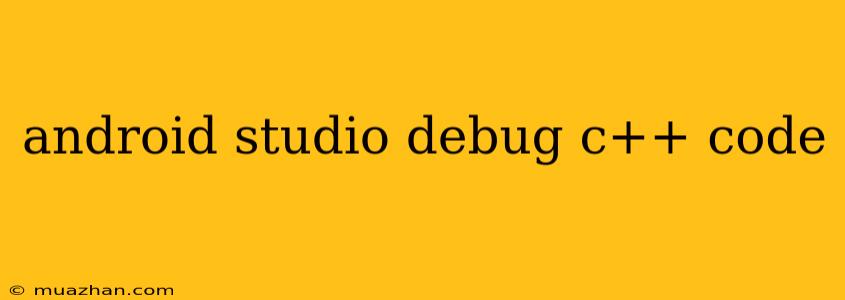Debugging C++ Code in Android Studio
Android Studio is a powerful IDE that offers robust debugging capabilities, including support for C++ code. Debugging C++ code can be a daunting task, but Android Studio provides various tools to help you identify and fix issues in your native code. This article will guide you through the process of debugging C++ code in Android Studio.
Setting Up for Debugging
-
Enable Native Debugging:
- In the "Run" configuration of your Android Studio project, go to the "Debugger" tab.
- Check the box for "Native Debugging."
- You can also specify other debug options such as "Debuggable" and "JniDebugger" for your debug build.
-
Compile with Debug Symbols:
- Ensure your C++ code is compiled with debug symbols enabled. This provides crucial information for the debugger to interpret.
- You can usually achieve this by adding the
-gflag during compilation or by setting the "Generate Debugging Information" option in your build system.
Debugging Using Android Studio
-
Set Breakpoints:
- Click in the gutter next to the line number where you want to set a breakpoint. This will pause the program execution at that line.
- You can set conditional breakpoints that only trigger when specific conditions are met.
-
Start Debugging:
- Start your app in debug mode by clicking the "Debug" button in Android Studio.
- The debugger will start and stop at the first breakpoint encountered.
-
Examine Variables and Expressions:
- The "Variables" view in the debugger window shows you the values of local variables, fields, and arguments at the current breakpoint.
- Use the "Evaluate Expression" feature to calculate the value of an expression in the current context.
-
Step through Code:
- Step Over: Executes the current line of code and moves to the next one.
- Step Into: Steps into the function call on the current line.
- Step Out: Executes the remaining code in the current function and returns to the caller.
- Run to Cursor: Continues execution until the cursor's location is reached.
-
Inspect Call Stack:
- The "Call Stack" view shows the sequence of function calls leading to the current breakpoint.
- You can navigate through the call stack to inspect the context of each function call.
-
Use the Console:
- The "Console" window provides a platform for interacting with the debugger and executing commands.
- You can print values, execute commands, and even modify the program's state during debugging.
Advanced Debugging Techniques
- LLDB Commands: Android Studio uses LLDB (Low-Level Debugger) as its underlying debugger. You can leverage LLDB commands for more advanced debugging tasks.
- Profiling: Use the "CPU Profiler" in Android Studio to analyze the performance of your C++ code and identify bottlenecks.
- Memory Debugging: Use tools like Valgrind to detect memory leaks and other memory-related issues in your native code.
Tips for Effective Debugging
- Clearly define your problem: Before starting to debug, clearly identify the issue you are trying to fix.
- Use meaningful variable names: This helps you understand the code and the context more easily.
- Log messages: Add log messages to your code to track the program's flow and provide more information during debugging.
- Don't be afraid to experiment: Try different debugging techniques to find the approach that works best for you.
By following these steps and using the tools provided by Android Studio, you can efficiently debug your C++ code and ensure a smooth development process for your Android applications.
